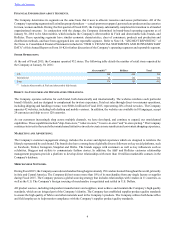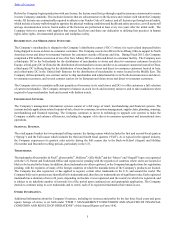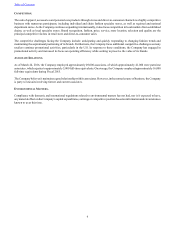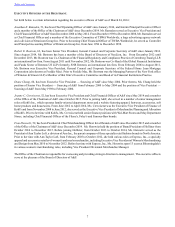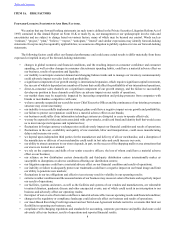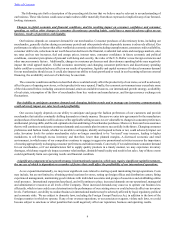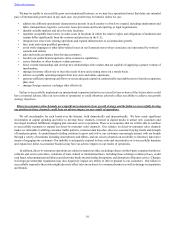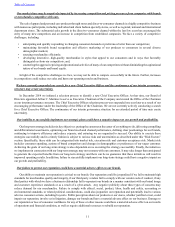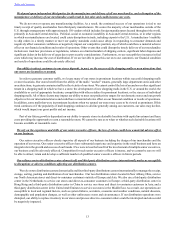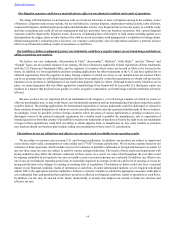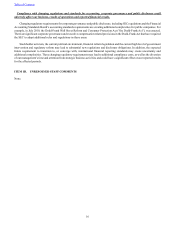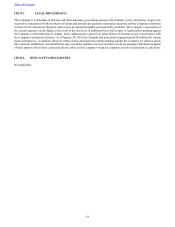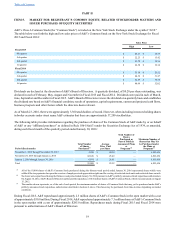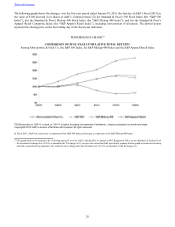Abercrombie & Fitch 2015 Annual Report Download - page 14
Download and view the complete annual report
Please find page 14 of the 2015 Abercrombie & Fitch annual report below. You can navigate through the pages in the report by either clicking on the pages listed below, or by using the keyword search tool below to find specific information within the annual report.
Table of Contents
14
Our litigation exposure could have a material adverse effect on our financial condition and results of operations.
We, along with third parties we do business with, are involved, from time to time, in litigation arising in the ordinary course
of business. Litigation matters may include, but are not limited to, contract disputes, employment-related actions, labor relations,
commercial litigation, intellectual property rights and shareholder actions. Any litigation that we become a party to could be costly
and time consuming and could divert our management and key personnel from our business operations. Our current litigation
exposure could be impacted by litigation trends, discovery of damaging facts with respect to legal matters pending against us or
determinations by judges, juries or other finders of fact that are not in accordance with management’s evaluation of existing claims.
Should management’s evaluation prove incorrect, our exposure could greatly exceed expectations and have a material adverse
effect on our financial condition, results of operations or cash flows.
Our inability or failure to adequately protect our trademarks could have a negative impact on our brand image and limit our
ability to penetrate new markets.
We believe our core trademarks, Abercrombie & Fitch®, abercrombie®, Hollister®, Gilly Hicks® and the “Moose” and
“Seagull” logos, are an essential element of our strategy. We have obtained or applied for federal registration of these trademarks
with the U.S. Patent and Trademark Office and the registries of countries where stores are located or likely to be located in the
future. In addition, we own registrations and have pending applications for other trademarks in the U.S. and have applied for or
obtained registrations from the registries in many foreign countries in which our stores or our manufacturers are located. There
can be no assurance that we will obtain registrations that have been applied for or that the registrations we obtain will prevent the
imitation of our products or infringement of our intellectual property rights by others. Although brand security initiatives are in
place, we cannot guarantee that our efforts against the counterfeiting of our brands will be successful. If a third-party copies our
products in a manner that projects lesser quality or carries a negative connotation, our brand image could be materially adversely
affected.
Because we have not yet registered all of our trademarks in all categories, or in all foreign countries in which we source or
offer our merchandise now, or may in the future, our international expansion and our merchandising of products using these marks
could be limited. The pending applications for international registration of various trademarks could be challenged or rejected in
those countries because third parties of whom we are not currently aware have already registered similar marks in those countries.
Accordingly, it may be possible, in those foreign countries where the status of various applications is pending or unclear, for a
third-party owner of the national trademark registration for a similar mark to prohibit the manufacture, sale or exportation of
branded goods in or from that country. Our inability to register our trademarks or purchase or license the right to use our trademarks
or logos in these jurisdictions could limit our ability to obtain supplies from, or manufacture in, less costly markets or penetrate
new markets should our business plan include selling our merchandise in those non-U.S. jurisdictions.
Fluctuations in our tax obligations and effective tax rate may result in volatility in our operating results.
We are subject to income taxes in many U.S. and foreign jurisdictions. In addition, our products are subject to import and
excise duties and/or sales, consumption or value-added taxes ("VAT") in many jurisdictions. We record tax expense based on our
estimates of future payments, which include reserves for estimates of probable settlements of foreign and domestic tax audits. At
any one time, many tax years are subject to audit by various taxing jurisdictions. The results of these audits and negotiations with
taxing authorities may affect the ultimate settlement of these issues. As a result, we expect that throughout the year there could
be ongoing variability in our quarterly tax rates as taxable events occur and exposures are evaluated. In addition, our effective tax
rate in any given financial reporting period may be materially impacted by changes in the mix and level of earnings or losses by
taxing jurisdictions or by changes to existing accounting rules or regulations. Fluctuations in duties could also have a material
impact on our financial condition, results of operations or cash flows. In some international markets, we are required to hold and
submit VAT to the appropriate local tax authorities. Failure to correctly calculate or submit the appropriate amounts could subject
us to substantial fines and penalties that could have an adverse effect on our financial condition, results of operations or cash flows.
In addition, tax law may be enacted in the future, domestically or abroad, that impacts our current or future tax structure and
effective tax rate.


